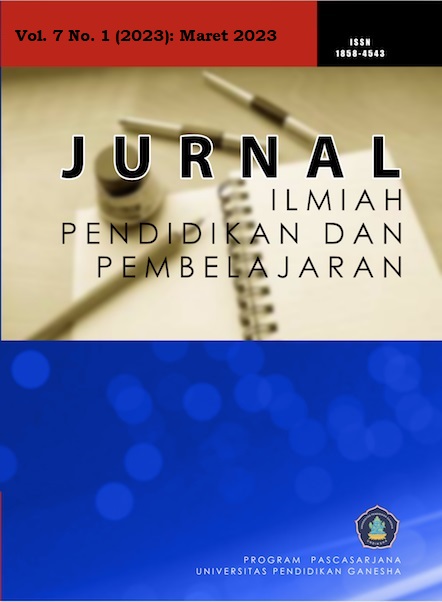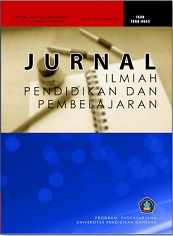The Implementation of Literacy Activities in Primary School
DOI:
https://doi.org/10.23887/jipp.v7i1.56108Keywords:
school literacy movement, literacy activities, ImplementationAbstract
School Literacy Movement is a program which has been voiced by the Indonesian Minister of Education and Culture since 2015. This program aimed to promote and support reading culture in school due to consistent unsatisfactory result of Program of International Student Assessment indicate the need for special effort to improve the young generation’s literacy skills. This study aimed at analyzing such efforts in the school level. The study employed a qualitative research design which explored the types of literacy activities implemented in the school to support literacy movement program. Classroom observation and interview were conducted to collect the data from Bali Kiddy School. There were 2 teachers who gave their consent to be involved in this study. The data were analyzed descriptively. These phases include categorizing the data, presenting the findings, and evaluating and validating the data. The finding reveals that the schools have some strategies to engage students to read non-subject books, write reading response journal, do spelling and writing activities. To encourage children's literacy development, building a literacy environment where they are highly exposed to the language is essential.
References
Alexander, J., & Jarman, R. (2018). The pleasures of reading non-fiction. Literacy, 52(2), 78–85. https://doi.org/https://doi.org/10.1111/lit.12152.
Anandari, C. L., & Iswandari, Y. A. (2019). Extensive reading in Indonesian schools: a successful story. TEFLIN Journal, 30(2), 137–152. https://doi.org/10.15639/teflinjournal.v30i2/137-152.
Azarnoosh, M. (2013). Peer assessment in an EFL context: attitudes and friendship bias. Language Testing in Asia, 3(1). https://doi.org/10.1186/2229-0443-3-11.
Berninger, V. W., & Fayol, M. (2008). Why Spellinag is Important and How to Teach It Effectively. Canadian Language & Literacy Research Network, 1, 1–13. https://hal.science/hal-00329944/.
Brown, C. S. (2014). Language and Literacy Development in the Early Years: Foundational Skills that Support Emergent Readers. Language and Literacy Development in the Early Years, 24, 35–48. https://doi.org/https://files.eric.ed.gov/fulltext/EJ1034914.pdf.
Cairney, T. (2011). The power of story: How literature can teach, enrich and transform. International Journal of the Book, 8, 37–47.
Creswell, J. W. (2012). Educational Research Planning, Conducting and Evaluating Quantitative and Qualitative Research (Fourth). Pearson Education, Inc.
Dispriyani, N., Ramli, M., Nurmiyati, N., & Suarjiana, T. (2015). Meningkatkan Scientific Writing Skill Siswa pada Pembelajaran Biologi Kelas X MIA 7 SMA N 4 Surakarta Menggunakan Guided Inquiry Learning Dipadu Reading Assignment. Bioedukasi: Jurnal Pendidikan Biologi, 8(2), 19–23. https://doi.org/10.20961/bioedukasi-uns.v8i2.3864.
Domike, G. C., & Odey, E. O. (2014). An evaluation of the major implementation problems of primary school curriculum in cross river state, Nigeria. American Journal of Educational Research, 2(6), 397–401. https://doi.org/10.12691/education-2-6-12.
Dong, Y., Dong, W. Y., Wu, S. X. Y., & Tang, Y. (2020). The effects of home literacy environment on children’s reading comprehension development: A meta-analysis. Educational Sciences: Theory and Practice, 20(2), 63–82. https://doi.org/10.12738/jestp.2020.2.005.
Ferrer, E., & Staley, K. (2016). Designing an EFL Reading Program to Promote Literacy Skills, Critical Thinking, and Creativity. CATESOL Journal, 28(2), 79–104. https://eric.ed.gov/?id=EJ1119613.
Firman, Aswar, N., Sukmawaty, Mirnawati, & Sukirman. (2020). Application of the Two Stay Two Stray Learning Model in Improving Indonesian Language Learning Outcomes in Elementary Schools. Jurnal Studi Guru Dan Pembelajaran, 3(3), 551–558. https://e-journal.my.id/jsgp/article/view/621.
Greaney, K., & Arrow, A. (2014). The Importance of Teaching Phonological-Based Spelling Skills. Kairaranga, 15(1), 20–25. https://doi.org/10.54322/kairaranga.v15i1.182.
Hadianto, D., S. Damaianti, V., Mulyati, Y., & Sastromiharjo, A. (2022). Effectiveness of Literacy Teaching Design Integrating Local Culture Discourse and Activities to Enhance Reading Skills. Cogent Education, 9(1), 0–13. https://doi.org/10.1080/2331186X.2021.2016040.
Harsanti, H. R. (2020). The Use of Orthography to Increase Young Learners’ Basic Literacy: Spelling Ability. ELT Worldwide: Journal of English Language Teaching, 7(2), 89. https://doi.org/10.26858/eltww.v7i2.13859.
Irvin, J. L., Meltzer, J., & Dukes, M. (2007). Taking Action on Adolescent Literacy: An Implementation Guide for School Leaders.
Joshi, R. M., Alves, R., Goswami, U., Chang, C. M., Oakhill, J., & Treiman, R. (2020). Reading-Writing Connections: Towards Integrative Literacy Service. 1–23. https://doi.org/10.1007/978-3-030-38811-9.
Karima, R., & Kurniawati, F. (2020). Kegiatan Literasi Awal Orang Tua pada Anak Usia Dini. Al-Athfal : Jurnal Pendidikan Anak, 6(1), 69–80. https://doi.org/10.14421/al-athfal.2020.61-06.
Kartikasari, E., & Nuryasana, E. (2022). School literacy movement program in elementary school, Indonesia: Literature review. Journal of Education and Learning (EduLearn), 16(3), 336–341. https://doi.org/10.11591/edulearn.v16i3.20383.
Khairuddiniyah, D. (2018). The Implementation of Literacy Strategies in Teaching English by the English Teacher at MAN Insan Cendekia Padang Pariaman. 10(20), 242–257. https://doi.org/10.2991/iconelt-17.2018.30.
Korosidou, E., Griva, E., & Pavlenko, O. (2020). Parental Involvement in a Program for Preschoolers Learning a Foreign Language. International Journal of Research in Education and Science, 7(1), 112. https://doi.org/10.46328/ijres.1219.
Lee, H. C. (2013). The reading response e-journal: An alternative way to engage low-achieving EFL students. Language Teaching Research, 17(1), 111–131. https://doi.org/10.1177/1362168812457539.
Levesque, K. C., Breadmore, H. L., & Deacon, S. H. (2021). How morphology impacts reading and spelling: advancing the role of morphology in models of literacy development. Journal of Research in Reading, 44(1), 10–26. https://doi.org/https://doi.org/10.1111/1467-9817.12313.
Liansari, V., Taufiq, W., & Santoso, D. R. (2021). The Implementation of Literacy Culture Programs in Elementary School. Jo-ELT (Journal of English Language Teaching) Fakultas Pendidikan Bahasa & Seni Prodi Pendidikan Bahasa Inggris IKIP, 8(2), 189. https://doi.org/10.33394/jo-elt.v8i2.4481.
Luthfiyyah, R., & Basyari, I. W. (2020). Journal on English as a Foreign Language EFL secondary teachers ’ assessment literacy : Assessment conceptions and practices. 10(2), 402–421. https://doi.org/10.23971/jefl.v10i2.2101.
Marhaeni, A. A. I. N., Dantes, N., & Paramartha, A. A. G. Y. (2018). Teacher Assessment Literacy: Discrepancies in Authentic Assessment Practice in EFL Context. Proceeding Book of 1st International Conference on Educational Assessment and Policy, 2, 18–21. https://doi.org/10.26499/iceap.v2i1.90.
Mielonen, A. M., & Paterson, W. (2009). Developing Literacy through Play. Journal of Inquiry & Action in Education, 3(1), 15–46. https://digitalcommons.buffalostate.edu/jiae/vol3/iss1/2/.
Montoya, S. (2018). Defining Literacy. Journal of Teacher Education, 51(4), 276–288. https://doi.org/10.1177/0022487100051004003.
Muhali, M. (2019). Pembelajaran Inovatif Abad Ke-21. Jurnal Penelitian Dan Pengkajian Ilmu Pendidikan: E-Saintika, 3(2), 25–50. https://doi.org/10.36312/e-saintika.v3i2.126.
Oktavia, Z., & Ridlo, S. (2020). Critical Thinking Skills Reviewed from Communication Skills of the Primary School Students in STEM-Based Project-Based Learning Model. Journal of Primary Education, 9(3), 311–320. https://doi.org/10.15294/jpe.v9i3.27573.
Padmadewi, N. N., Artini, L. P., Budiarta, L. G. R., & Apriliadewi, P. A. R. (2020). Primary Literacy Activities in Basic Education in Bali: Describing Implication on Children Reading and Writing in EFL. Proceedings of the 3rd International Conference on Innovative Research Across Disciplines (ICIRAD 2019), 184–189. https://doi.org/https://doi.org/10.2991/assehr.k.200115.030.
Popoola, G. A., Amoo, O. K., Umar, O. G., Popoola, A. A., & Olatunji, O. M. (2020). Influence of reading habit on student academic performance in a senior second school in Ibadan. Multifaceted Strategies for Social-Emotional Learning and Whole Learner Education, 141–162. https://doi.org/10.4018/978-1-7998-4906-3.ch007.
Puspitasari, P. I., Padmadewi, N. N., & Dewi, L. P. E. S. (2021). Various English Literacy Activities in Bilingual Primary School. International Journal of Elementary Education, 5(1), 48. https://doi.org/10.23887/ijee.v5i1.31550.
Ratama, I. P., Padmadewi, N. N., & Artini, L. P. (2021). Teaching the 21st Century Skills (4Cs) in English Literacy Activities. Journal of Education Research and Evaluation, 5(2), 223. https://doi.org/10.23887/jere.v5i2.30849.
Sénéchal, M. (1997). The differential effect of storybook reading on preschoolers’ acquisition of expressive and receptive vocabulary. Journal of Child Language, 24(1), 123–138. https://doi.org/10.1017/S0305000996003005.
Strouse, G. A., Nyhout, A., & Ganea, P. A. (2018). The role of book features in young children’s transfer of information from picture books to real-world contexts. Frontiers in Psychology, 9(FEB), 1–14. https://doi.org/10.3389/fpsyg.2018.00050.
Venketsamy, R., & Sibanda, S. (2021). Exploring strategies teachers use to develop literacy skills among english first additional language learners in the foundation phase. Perspectives in Education, 39(2), 253–266. https://doi.org/10.18820/2519593X/pie.v39.i2.18.
Wahab, I., & Amaliyah, N. (2021). The Implementation of School Literacy Movement in Elementary School. 5(3), 393–400. https://doi.org/10.2991/icei-17.2018.12.
Weigle, S. C. (2002). Assessing Writing. Cambridge University Press.
Whitten, C., Labby, S., & Sullivan, S. L. (2016). The impact of Pleasure Reading on Academic Success. The Journal of Multidisciplinary Graduate Research, 2(4), 48–64. https://jmgr-ojs-shsu.tdl.org/jmgr/article/view/11.
Downloads
Published
How to Cite
Issue
Section
License
Copyright (c) 2023 Pradnyani Prawira, Luh Putu Artini, Ni Putu Era Marsakawati, Ni Nyoman Padmadewi , Ni Made Ratminingsih , IGA. Lokita Purnamika Utami

This work is licensed under a Creative Commons Attribution-ShareAlike 4.0 International License.
Authors who publish with the Jurnal Ilmiah Pendidikan dan Pembelajaran (JIPP) agree to the following terms:
- Authors retain copyright and grant the journal the right of first publication with the work simultaneously licensed under a Creative Commons Attribution License (CC BY-SA 4.0) that allows others to share the work with an acknowledgment of the work's authorship and initial publication in this journal.
- Authors are able to enter into separate, additional contractual arrangements for the non-exclusive distribution of the journal's published version of the work (e.g., post it to an institutional repository or publish it in a book), with an acknowledgment of its initial publication in this journal.
- Authors are permitted and encouraged to post their work online (e.g., in institutional repositories or on their website) prior to and during the submission process, as it can lead to productive exchanges, as well as earlier and greater citation of published work. (See The Effect of Open Access)










